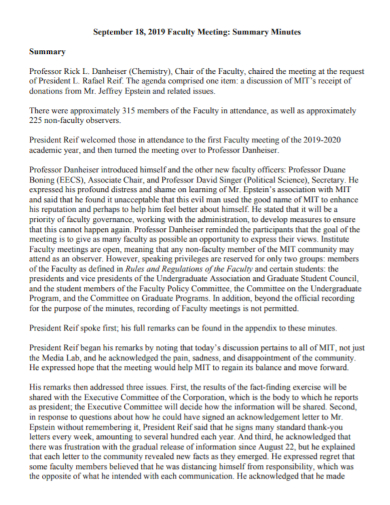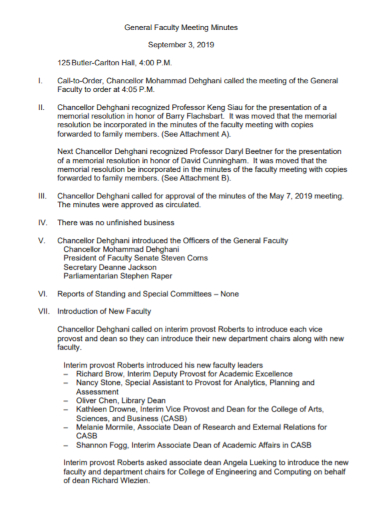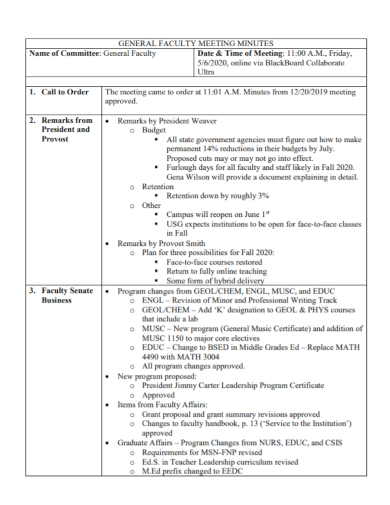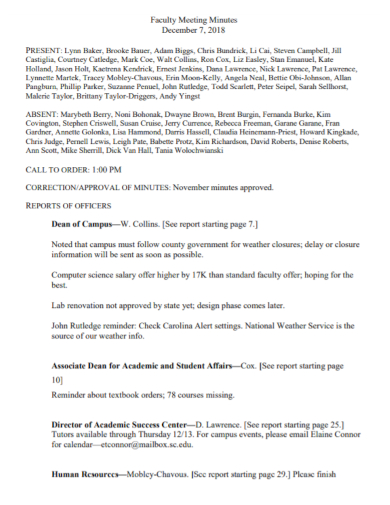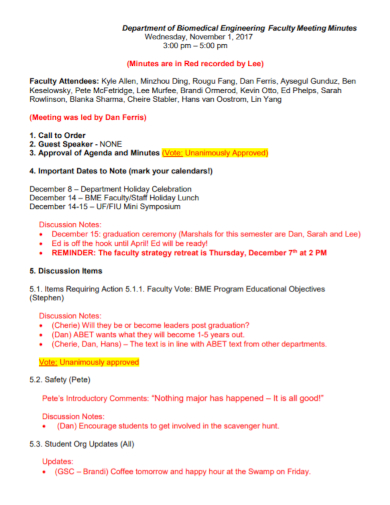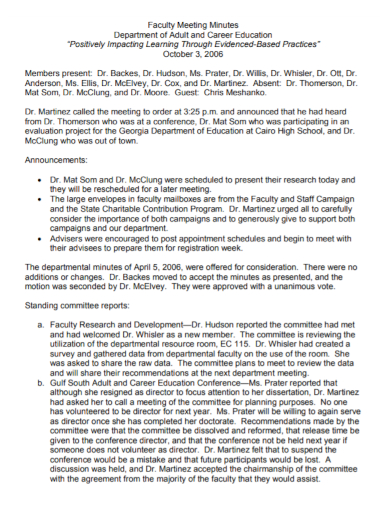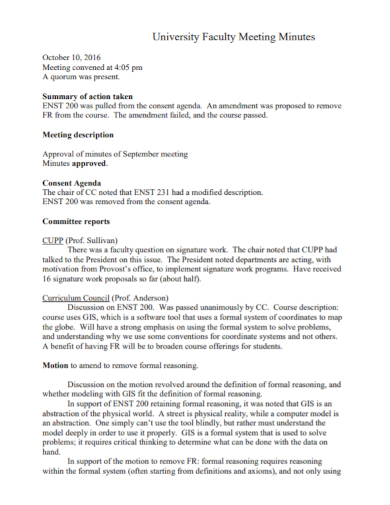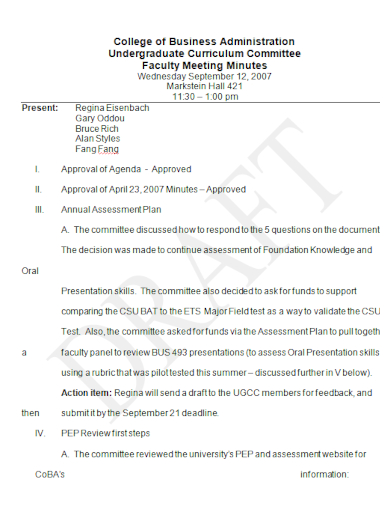In every team, company, and organization, collaboration is and has always been a must. Members and leaders, especially in a governing body like a faculty, needs to be able to establish a clear medium for communication with each other. This can be achieved by gathering routine feedback from one another, especially those who are directly affiliated with the group such as the members and the leaders. They have to be able to actively participate in the decision making process of the whole faculty and keep everyone up to date. Faculty meetings are necessary for this main reason. Keep everybody well informed and tackle faculty issues together for maximum efficiency and better decision making.
But meetings are not really effective if the circulation of information stopped at the end of the meeting. You also need to keep track of what transpired during the meeting, making a summary out of it, and take everything else into account. That why if there’s a faculty meeting, there should always be a faculty meeting minutes.
Minutes of the meeting are the notes that are recorded during the duration of the faculty meeting. These help highlight the key issues that have been discussed, motions that have been moved or proposed, items that have been voted on, and the tasks or activities that need to be done. It serves as sort of an outline to keep track of what transpired during the meeting and a written record for the people who were not able to attend. Minutes usually cover what happened and what decisions were made by the faculty. It’s a massively important tool, especially for governing bodies such as the faculty of a school or university, when important decisions will basically dictate which direction will the curriculum be taken or what interschool decisions have to be made.
Minutes of the meeting can greatly help disseminate these information and more, and can be used as a reference point for the next meetings hereafter. To get yourself properly acquainted with what the document is and what it looks like, check out these faculty meeting samples that we have listed down below. After that, you can use these samples as a guide or even as a template for your own faculty meeting minutes.
10+ Faculty Meeting Minutes Samples
1. College Faculty Meeting Minutes
2. Faculty Meeting Minutes
3. Faculty Meeting Summary Minutes
4. General Faculty Meeting Minutes
5. General Faculty Committee Meeting Minutes
6. Campus Faculty Meeting Minutes
7. Engineering Faculty Meeting Minutes
8. Career Education Faculty Meeting Minutes
9. University Faculty Meeting Minutes
10. Dance Department Faculty Meeting Minutes
11. Business Administration Faculty Meeting Minutes
What Is a Faculty Meeting Minutes?
Faculty meeting minutes are, well, minutes of the meeting essentially. These as official documents that contains a written record of the meeting of the entire body of the faculty. Minutes are documents that can have multiple purposes such as tracking progress, provide details of future plans, and to serve as a solid reference point. Minutes also reflect a record of the motions, votes, and the current attendees of the meeting. Overall, it’s an official summary of what has transpired during the meeting. Remember that it’s a record of actions, not of everything that has been said. It’s more of a transcript of the events, not a verbatim transcript. A summary, so to speak. To write a minutes of the meeting, a designated member of the group is usually assigned to the task. The task to provide an accurate written record of the events of the meeting.
What Should Be Included in a Faculty Meeting Minutes
Once an individual is chosen and assigned to take the minutes of the meeting, it’s important for them to have a clear idea of what their designated task is. They can choose to approach the head of the faculty and ask what the parameters are for the minutes of the meeting. For example, if something is to be voted on during the meeting, they should ask whether they’ll include to list down the names of those who voted for and against or not. And before actually recording any details, they have to be familiar with the information that they are trying to jot down. Some faculty administrations may have their own specific format in recording notes. Regardless, a minutes of the meeting will usually include the following details.
- Date
- Exact date and time of when the meeting happened, following a proper dating format.
- Attendance
- Names of the attendees, and a separate list for those who are absent or tardy
- Motions from the previous meeting’s minutes
- Basically the acceptances, amendments, and confirmations made regarding the minutes of the last meeting.
- Decisions and motions pertaining to the current agenda
- Activities agreed upon
- Steps and proceedings
- Voting outcomes
- Motions that have been accepted or rejected
- Old, new, and current businesses
- The details for the next official faculty meeting
After the meeting ends, the taker of the minutes should be able to gather the resources they need to write the clear and presentable version of the minutes of the meeting. Nope, you don’t just write everything down and call it a day, you actually have to format it according to the specifications provided by the head of faculty, or at least following the order of the elements listed above. Make sure to draft the final minutes of the meeting while everything is still fresh in your mind, review and outline the motions and decisions that have been made earlier, and clarify information whenever necessary. Finally, make final revisions making sure everything is clear and concise.
FAQs
What are helpful tips for taking the minutes of the meeting?
- Use a template like the one we’ve provided above
- Take attendance as soon as people arrive
- Make introductions or create an organized list of attendees
- Keep track of the motions, activities, and choices as they happen
- Seek clarification as needed
- Make sure that the notes you are taking are clear and concise, doesn’t have to be complete sentences of perfectly verbatim, ideas are enough.
Are teachers faculty or staff?
The main difference between faculty and staff is that faculty is referred to a group of teachers who teach academics or educators of a teaching institution, while staff refers to a group of people who do work other than teaching.
What should be included in the minutes of a meeting?
The minutes should be able to cover the title of the organization of which the faculty belongs to, the date, time, and venue, the attendance, the name of the taker of the minutes of the meeting, and the agenda.
Minutes of the meeting are generally crucial because they provide a clear record of the main points and motions that have transpired during the duration of the meeting. Especially faculty meetings where they generally talk about the status of the current education of the students or the changes that have to be made on the curriculum.
Related Posts
FREE 10+ Research Meeting Minutes Samples
FREE 10+ Staff Directory Samples
FREE 10+ Charity Meeting Agenda Samples
FREE 10+ Team Agenda Samples
FREE 10+ Meeting Summary Report Samples
FREE 8+ Sample Incompetech Graph Paper
FREE 7+ Sample Board Meeting Agenda
FREE 7+ Sample Staff Roster
FREE 6+ Sample Staff Report
FREE 39+ Agenda Examples
FREE 17+ Party Agenda Samples
FREE 10+ Staff Consultation Policy Samples
FREE 9+ Sample Music Lesson Plan
FREE 7+ Sample Staff Manual
FREE 5+ Sample Instructional Manual



